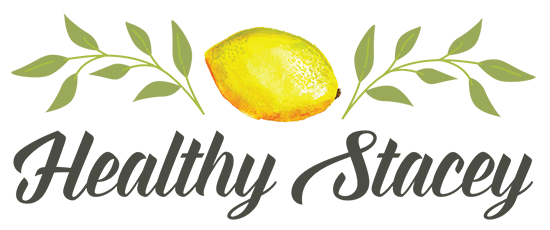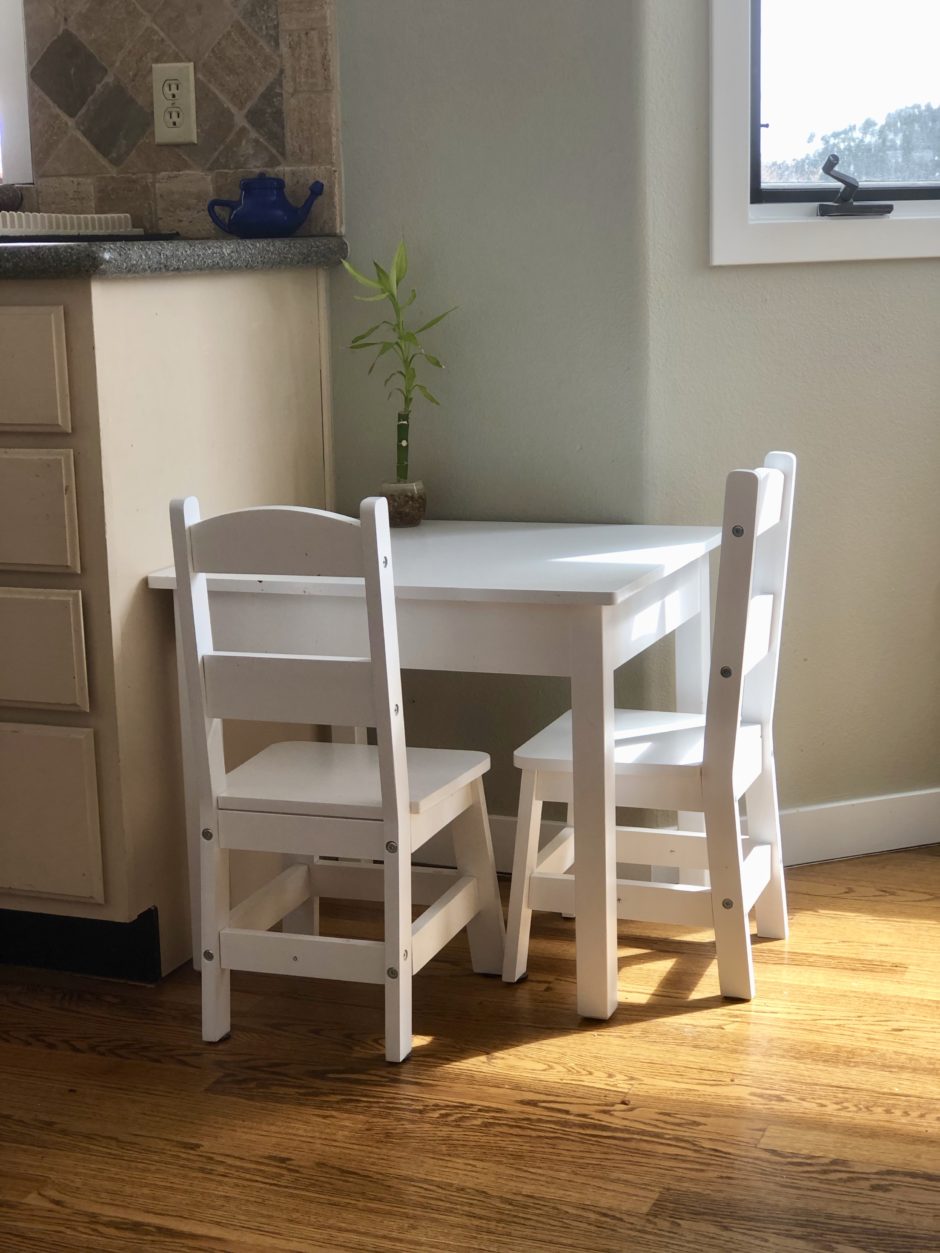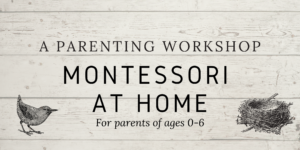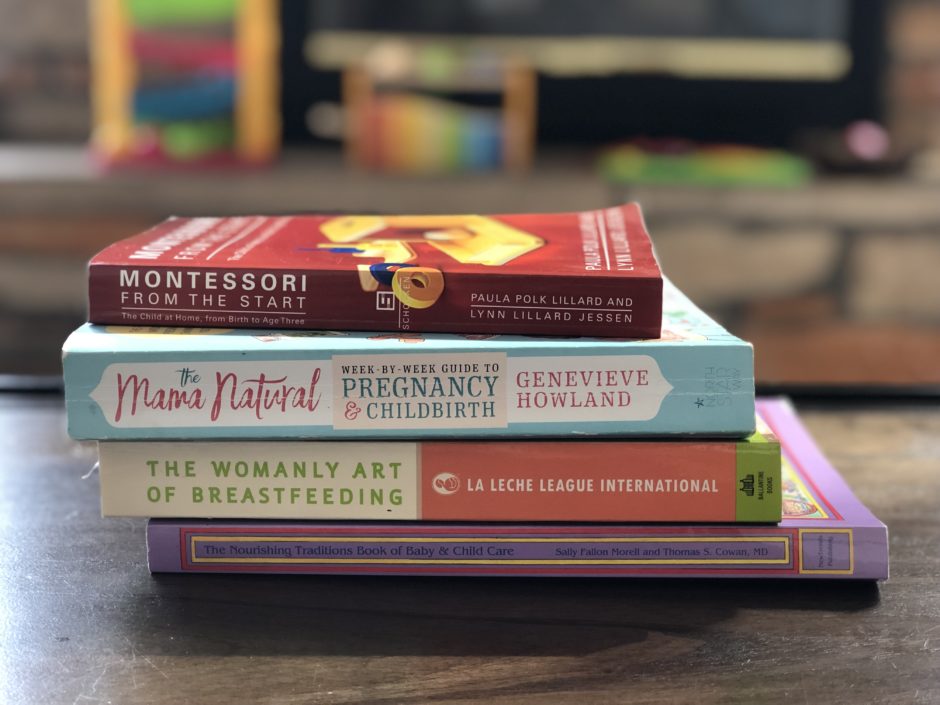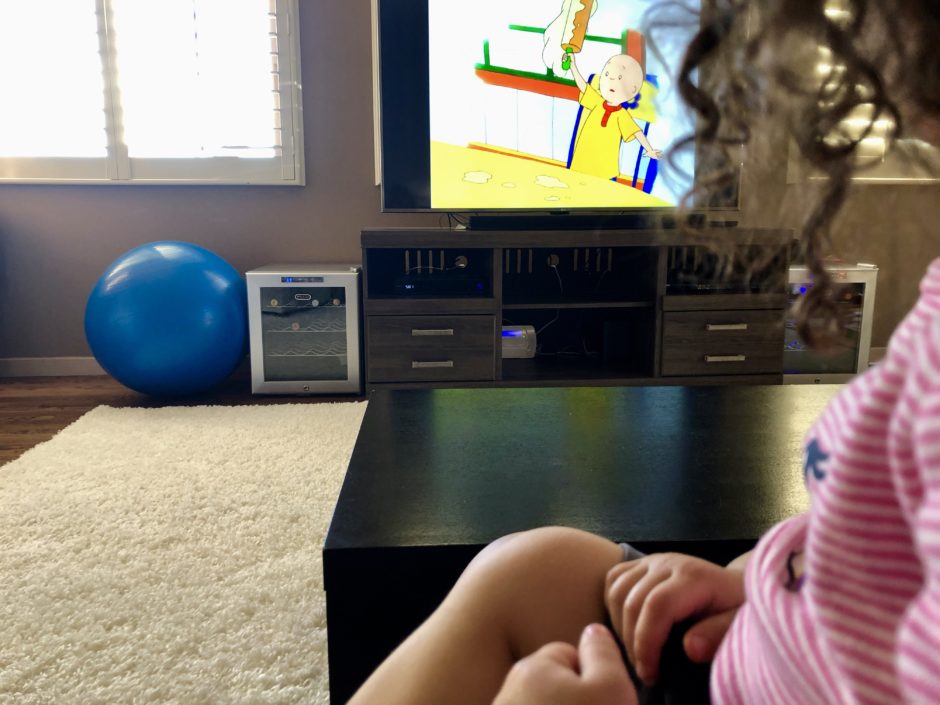My first exposure to Montessori was through a friend who was trying to help me through my toddler-food-throwing woes. She told me how her daughter doesn't use a high chair, and instead sits at a child-size table and chair for all her meals. She had found that her daughter fought a lot less at meal times when she was in control of sitting down and getting up. The idea sounded so simple, yet profound. Her own table? At 14 months? Isn't that too early? I thought. But I decided it was worth a try.
So glad I did because it made all the difference. You should've seen the look on Charley's face when she set eyes on her very own Charley-sized table, and her very own Charley-sized chair. She inspected it, she sat on it, she got up, she sat again. And come meal time, she was actually excited to sit at her table. I'm happy to say that the food throwing has significantly decreased (she still has her shining moments every once in awhile), and overall, we enjoy meal time. We've even added a plant she named "Ned" that serves as decor, but also her responsiblity to water (with my help). This concept, in my opinon, is the cornerstone of the Montessori philosophy: independence for the child (as much as they and you are able).
Over the next few months, I couldn't help but learn more. I got books, read blogs, found online courses, and talked to other Montessori moms. They were on to something. And maybe you'll think so too. If you don't already know about the Italian-inspired education philosophy, today I'm going to shine a little light on Montessori parenting.
Montessori Parenting
In a nutshell:
Education with a child-centered environment where children have freedom within limits. Freedom to choose their work (i.e. play) based on their age/developmental level and interests. But limits for their safety and their comfort level.
Known for:
It’s specialty schools and wooden toys.
Founder:
Maria Montessori, an Italian physician and educator who used observational research to create an educational method based on the way children learn naturally. Her first school was founded in Rome in 1907. Today, it is estimated that there are about 4,500 Montessori schools in the US and about 20,000 worldwide (source).
Popular Resources:
Organizations:
Blogs:
Books:
Products:
- Monti Kids
- Montessori Outlet
- Melissa and Doug
- Ikea (for kids furniture)
The Basic Principles:
- Independence
- Observation
- Following the child
- Correcting the child
- Prepared environment
- Absorbent mind
Independence
The first step to incorporating Montessori-style parenting into your house is to provide your child with as much autonomy as possible at their current stage of development. As old Maria says, “never help a child with a task at which he feels he can succeed.” How do you provide your toddler or even a baby with independence, you ask? Opportunities. Keep your eyes open throughout the day of any opportunities that allow your child to do things on their own, or with little assistance. When you do this, it increases their self-confidence, and according to Montessori, this confidence will carry on with them as they become an adult.
In practice:
In our house, Charley can do the following things by herself:
- set the table (i.e. bring her plate, fork, and placemat to the table)
- bring her plate back to me at the sink when she’s finished eating
- push in her chair when she’s finished eating
- bring me her shoes and help me put them on
- hang her coat on the chair by the door
- turn our lights on and off
- help me unload the dishwasher (after all the knives have been removed)
- peel a banana
- mash a banana
- stir eggs (we’re not quite to whisking)
- “sweep” with her broom and dust pan (actually collecting the dirt off the floor is another story)
- “wash” her table with a sponge (I typically go over it after her)
- and water her plant.
All seemingly menial tasks, but for a 1-and-a-half-year-old, these are huge. When I first started practicing independent tasks with Charley, I almost threw in the towel (literally, the sopping wet towel from all of the mess she was creating). About three months later, however, I’ve seen how much she’s accomplished and I’m amazed at what she’s able to do if I give her the tools to do it (more on tools later).
Observation
Sitting, watching, observing. This is how Maria Montessori started all of her research. In her opinion, this is the best way adults can learn about the child — their needs, their likes, their dislikes.
In practice:
Charley is fascinated with shoes, and really all things feet. I don’t know where she got it from because as somebody with very flat, size 12 feet, shoes have never been something I enjoy. After noticing this, I decided to give her a “shoe playground” by laying out a variety of shoe options — my yellow converse shoes, her dad’s blue running shoes, flip flops, and her orange boots. To see the look on her face when she came down from her nap. Ah. It was pure bliss. She spent the rest of the afternoon traipsing around in shoes that were way too big for her feet. I also capitalize on this when it’s time to get ready. When she’s dragging her feet, all I have to say is “Charley, get your shoes!” and she’s on top of it. Because I observed, I understood what fulfills her.
Following the Child
Now that you have observed your child, follow their lead. I don’t mean this when it comes to dangerous, destructive, or untimely undertakings. But when it’s play time, let them be the leader. If they want to climb, let them climb (on a safe-to-climb surface). If they want to play with their boat upside-down, let them do so without telling them or showing them the “right” way to do it. Present them with options, and then let them choose what they want to do. After all, the whole point of playing is so they can discover, learn, and enjoy themselves; not so you can tell them how to.
In practice:
Charley and I attend an activity called Tumblebugs every Friday. It’s a real-deal gymnastics gym, complete with all of the bells and whistles — uneven bars, vaults, balance beams, rings, a giant trampoline, a jumping pad, tunnels and ramps made of cushy mats, a thick hanging rope that leads into a and a humongous foam ball pit that will make your inner child want to do a cannonball. When we arrived, I couldn’t wait to see what Charley would do with all of it. You know what she spent the majority of her time on the first three sessions? A red plastic rocking boat. I was annoyed. I remember trying to pull her off it and show her how cool all of the other apparatuses were. She would kick and scream and inevitably, run right back to that stupid boat. Right around the same time, I was reading all about Montessori. And so, the next Tumblebugs session, I let it go. She rocked and rocked that boat for what felt like forever with a big grin on her face the whole time. But you know what? Eventually, she got off. And she went to explore on her own. First, the mat made to act as a slide, then the trampoline, the balance beam, and back to that boat. I guarantee she had much more fun that day, and guess what? So did I.
Correcting the Child
We all make mistakes. But children make them more than anyone. Not surprising considering their brains are not fully developed yet and this world is still pretty new to them. All this to say, give them a break. Montessori doesn’t believe there is any reason to correct your child or scold them if they spilled milk or accidentally broke a plate. Instead, recognize it as an opportunity to do some practical work and let them help you clean it up (unless it’s broken glass or ceramic obviously). The theory goes that constantly correcting your child will make them more hesitant to attempt anything on their own for fear of making a mistake.
In practice:
Just like many kids Charley’s age, she has her own special way of saying words. “Wawa” is water, “Bee” is bib, “Kock” is sock (yes, I realize what that sounds like), and “Woof” is dog, and “Deeg” covers a wide range of animals. Instead of correcting her on any of these, I just repeat the word back to her in context in the correct form. Honestly, I’m just happy she’s talking and not worried in the least that she won’t learn the correct way to say "sock" (otherwise, she may end up in the principal’s office on the first day of school).
Prepared Environment
Montessori believes the development of the child is dependent on the environment that he or she is in. They emphasize beauty (wooden toys versus noisy plastic ones), simplicity (less is more — when it comes to toys and clutter), and activities that are intended to challenge the child at the age and/or development level they are at. If you want to visualize what I’m talking about, just Google image “Montessori shelves,” “Montessori kitchen” or “Montessori bedroom.” You’ll get the idea. Here’s a short list of some things that make a “Prepared Environment”:
- A low shelf that displays 5-7 toys at a time, with the intention of rotating these toys every 2 weeks or so to keep things fresh and exciting (and no overflowing toy box in sight).
- A self-care area complete with mirror, brush and comb, tissues, and maybe a seat so your child can start to explore what it means to take care of their body.
- A play kitchen turned “real kitchen” stocked with real plates, silverware, a place mat, cups, and maybe a few kitchen supplies that your child can use to set his or her table before meal time.
- A small table and chairs, easy enough for your child to get in and out of by themselves. This is to be used for meals instead of a high chair, empowering them to set the table, sit down, and get up independently.
- Low hooks for their coat and bag by the entrance, along with a small basket for their shoes.
In practice:
I find this principle to be the most off-putting and intimidating of all the Montessori tactics. It’s not that I don’t believe it could be beneficial. I would to have some Montessori consultant come redesign my home to be more accessible to Charley. Or go to town on Amazon and buy all new beautiful wooden toys that keep her occupied for half-hours at a time. But that’s not going to happen anytime soon. I think it’s really easy to get caught up in the Montessori toys and tools or write it off all together because you can’t afford such an investment. I try to implement some of these ideas in little ways throughout the house, spending little to no money to do it. For example, I keep a low drawer stocked with plastic plates (not ceramic because I am just not that brave), 1-2 forks, and a place mat so she can set her table when I say lunch or dinner is ready. I use our fireplace as our “low shelf” to display 5-6 toys on. And I rarely rotate the toys because we just don’t have that many toys. Especially fancy wooden ones. And any effort to give her a self-care station has resulted in torn tissues all over the floor and a brush tangled up in her thick curly hair.
Absorbent Mind
This one is actually pretty cool. Through her research, Maria discovered that children under the age of three do not need to be taught in order to learn. Learning is achieved through absorbing their environment. In fact, research shows that children develop 85% of their core brain structure by the time they are five years old (source). Much of this, as you can imagine, is just by taking it all in — the way mom walks, how brother jumps, the way Dad’s lips move when he speaks. Keep in mind, though, every time you say Sh#*, or tell them “No!” soon enough, they will be spitting the words right back at you.
Montessori Tip: instead of constantly saying “No,” try to replace it with the thing you want them to do or try “Stop”.
In practice:
That’s the beauty of this one. You don’t really have to “do” anything. At least not intentionally. A few months back, I got really caught up in the idea of making Charley a lesson plan. I felt that she wasn’t getting the “education” she could be getting if she attended daycare. It took me poring hours into this three-ring binder (complete with activity list and inspirational quotes) to realize that she doesn’t need a lesson plan. Waking up is a lesson. Spilling water is a lesson. Listening to me talk is a lesson.
Stay tuned for the next philosophy breakdown: RIE. Thank you so much for reading.
Much Love,
p.s. If you live in the Denver west suburbs, and all this Montessori talk piqued your interest, I've got something for you. I'm running a workshop with this incredible Montessori teacher from Longomont. It's happening May 20th, 7-9 pm at the Golden Community Center. Here is the link to get tickets. Would LOVE to see you there.
